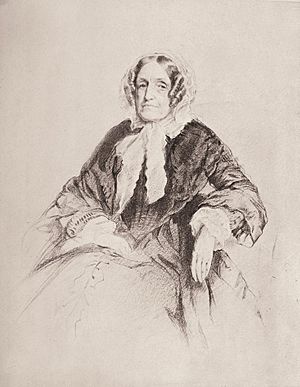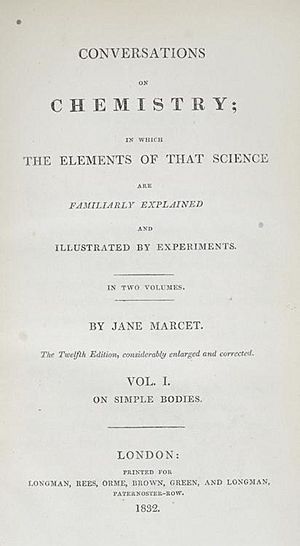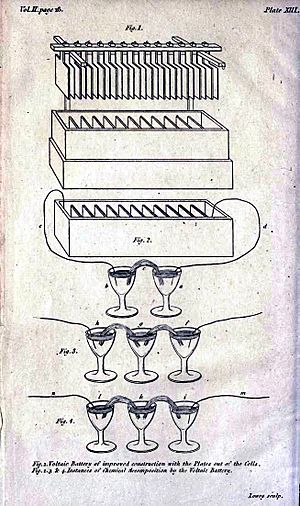Jane Marcet facts for kids
Jane Marcet (born Jane Haldimand) was an English writer and host of social gatherings. She was very good at explaining science in a simple way. She also wrote new kinds of books about economics. Her book Conversations on Political Economy (1816) helped explain the ideas of famous thinkers like Adam Smith and David Ricardo.
Contents
Jane Marcet's Life Story
Jane Marcet was born in London on January 1, 1769. She was one of twelve children. Her father, Anthony Francis Haldimand, was a rich banker from Geneva. Jane was taught at home with her brothers. She learned many subjects, including Latin, chemistry, biology, and history. These were not common subjects for young girls at that time.
When Jane was 15, her mother died. Jane then took charge of the family home. She helped raise her younger brothers and sisters. Her younger brother, William Haldimand, later became a director of the Bank of England. Jane also helped her father entertain many important scientists and writers. She loved painting and studied with famous artists like Joshua Reynolds. Her art skills later helped her draw pictures for her books.
In 1799, Jane married Alexander John Gaspard Marcet. He was a doctor from Geneva, Switzerland. They lived in London and had four children. One of their sons, François Marcet, became a well-known physicist. Alexander was very interested in chemistry. He taught at Guy's Hospital and was a member of the Royal Society. Jane also became interested in chemistry. They did experiments together in their home lab and talked about science.
The Marcets had many famous friends. These included writers and scientists like Mary Somerville and Maria Edgeworth. Maria Edgeworth once wrote about the Marcet family. She said they had lively children and welcomed visitors. She told a story about them making a huge paper hot-air balloon. Many people came to watch it fly!
Jane and her father were always very close. He lived with Jane and Alexander after they married. When her father died in 1817, Jane received a lot of money. This allowed Alexander to stop working as a doctor and focus on chemistry. Alexander always supported Jane's desire to learn and work.
Her Famous "Conversations" Books
Jane Marcet helped her husband check his books. This made her decide to write her own. She wrote books about chemistry, botany, religion, and economics. She called them "Conversations." In her books, she explained that women should also learn about these subjects. She believed that many people agreed with her.
Her first "Conversations" book was written in 1805. It was called Conversations on Natural Philosophy and was published in 1819. It taught about physics, mechanics, and astronomy. Her books used a special format: a conversation between a teacher, Mrs. Bryant, and two students, Caroline and Emily. Caroline, the younger student, asked simple questions. Emily was more thoughtful. Mrs. Bryant guided them to explore their ideas. This way of teaching made science easy to understand.
Jane's most famous book was Conversations on Chemistry, Intended More Especially for the Female Sex. It was published without her name in 1805. This book explained the work of chemist Humphry Davy. It was one of the first basic science textbooks. Jane drew pictures of chemistry tools for the book. She showed how important experiments were. Her name was not on the book until the 12th edition in 1832. The book had 16 editions in England. It even inspired a young Michael Faraday, who became a very famous scientist. The book was copied many times in America, with at least 23 editions.
Marcet also made the ideas of economists like Adam Smith and David Ricardo popular. She did this in her book Conversations on Political Economy (1816). This book was well-liked and widely read. Some later economists, like Alfred Marshall, didn't think it was important. Joseph Schumpeter even joked it was "economics for schoolgirls." But Jane Marcet had an important goal. Her character, Mrs. B, once told a student who thought women didn't need to know about economics, "When you argue for being ignorant, it's very likely you are wrong." Jane's book inspired Harriet Martineau to write about economics too.
In 1820, the Marcets went to Geneva, Switzerland. They planned to live there. But in 1822, Alexander died suddenly while visiting Britain. Jane was very sad. She went through a period of depression. Even though she stayed close to her Swiss friends, she eventually moved back to England.
She kept working in science and updated her books throughout her life. Her last edition of Conversations on Chemistry came out when she was 84 years old. Later in life, Jane wrote new books mostly for children. She might have been thinking of her grandchildren. Her book Mary's Grammar (1835) became a classic. Jane Marcet lived with her daughter in London. She died there on June 28, 1858.
Jane Marcet's Legacy and Influence
Jane Marcet's biggest impact was as a teacher. Her books didn't have many new ideas of her own. Instead, she carefully studied what scientists were saying at the time. She also wrote many letters to scientists to stay updated. Her books were known for being exact, accurate, and thorough. She explained science and economics in a friendly way. Her simple introductions to complex topics were loved by adults and children. Most importantly, her books reached women. At that time, women were not often encouraged to study science.
Jane was perfect for making chemistry and economics popular. She knew many of the greatest thinkers and scientists of her time. She helped make these new fields widely known. By writing in English and in a conversational style, she made science easy to understand. Not just for women, but also for men who hadn't learned Latin or Greek. Her first goal was to teach women. But she ended up reaching many more people. She showed that science should be for everyone.
In 1865, the Boston Girls' High and Normal School was the first school in America to teach science with lab work to women. They used Marcet's Conversations on Chemistry as their textbook. Even in 1898, when Henry James wrote The Turn of the Screw, Marcet's books were still common textbooks.
Inspiring Michael Faraday
One of the world's greatest scientists, Michael Faraday, read Jane Marcet's work. He was born in 1791. He was very impressed by her chemistry book. It helped him discover his love for science. He later said her book was very important for his career as a chemist.
Faraday once said that when he met Mrs. Marcet, he often thought back to how she first taught him. He loved connecting his past learning with his present work. He even sent her his own scientific papers as a thank you.
Her chemistry book aimed to help anyone who found chemistry confusing. She explained things better than other textbooks, but her explanations were still scientifically correct. It was an easy-to-use book. The topics were split into two parts, each over 300 pages long. It showed conversations between an adult teacher and two children. Jane also added her own drawings to help explain chemistry clearly. In England, 16 editions of Conversations on Chemistry were published until the 1830s. Each new edition had updates. She influenced people all over the world. Girls and people who were not rich could learn chemistry easily from her book.
Many people recognized Jane Marcet's support for teaching chemistry to beginners through experiments. After the American Civil War, lab teaching became normal in American schools. Even with many other authors and books, Jane Marcet's Conversations on Chemistry was key to helping women learn more. The book's popularity in the early 1900s showed that American schools were more willing to teach basic science to girls. This helped more women get involved in science. She inspired many great chemists, scientists, and mathematicians. Mary Somerville, a mathematician born in 1790, said of Jane Marcet: "No one at this time can truly understand how important Mrs. Marcet's scientific works were."
Her book was also very popular in the United States. This was partly because other authors, like John Lee Comstock, published many versions of it. Because there were no international copyright laws, Jane didn't get paid for these American editions. Her book was used as a standard textbook in Britain and the United States. It was also translated into German and French. In 1865, Boston's Girls' High School and Normal School became the first school to teach science to women through lab work. They used Marcet's Conversations on Chemistry as their guide.
Explaining Economics
Jane was inspired by economists like David Ricardo and Adam Smith. She wrote Conversations on Political Economy in 1816. This book became famous for explaining the ideas of these economists. The book aimed to teach general ideas about economics. It wanted to help and educate poor people, no matter their gender. It taught basic ideas about property, taxes, how work is divided, money, wages, and population.
In a letter to Pierre Prévost, Jane Marcet clearly stated: "I can promise you that the greatest joy I get from success is the hope of doing good. I want to spread useful truths among people who would never learn them otherwise, except in a simple, friendly way."
The book was well-received and became popular. Later, some economists like Alfred Marshall didn't value her work, which hurt her reputation. Joseph Schumpeter even made fun of it as "economics for schoolgirls." But her book had an important goal. It was more than just making money for small markets. It wanted to make economics popular for working-class people who wanted to improve themselves. It also aimed to be used in school lessons. It tried to simplify economics for a wider audience. It taught young people about how markets work using simple stories. Marcet's Conversations on Political Economy inspired Harriet Martineau. She was a British writer often called the first female sociologist. Martineau was inspired to include economic topics in her own writings. She learned from Jane to teach economic ideas by showing how they work in real life. Her book followed a similar style to Jane's and also became popular.
After her father died in 1817, Jane Marcet inherited a lot of money. She and her husband moved to Geneva in the 1820s. Two years later, Alexander died. Jane eventually moved back to London. There, she again spent time with important thinkers and bankers. Her later books were often on simpler topics and were for younger readers.
She also had success with Conversations on Natural Philosophy, published in 1819. She had written this book before Conversations on Chemistry. She didn't put her name on it until 1832. Other notable books from this time included Mary's Grammar (1835).
Because Jane Marcet didn't put her name on her early books, male authors in the United States could publish their own versions. They would even put their names on the title page as authors. When Marcet published the 12th edition of Conversations on Chemistry with her name, it caused confusion. But nothing changed in the end. Because there were no international copyright laws, Jane never received money for any editions published in the United States under other authors' names.
While Marcet published other popular works, like Conversations on Political Economy and Conversations on Plant Physiology, none became as widely read as Conversations on Chemistry.
Jane kept updating her book with each new edition. In 1845, she wrote to Michael Faraday, a respected scientist and member of the Royal Society. She asked him for detailed information about his latest research. He shared his newest discoveries with the woman who had first started him on his chemistry journey.
Sharing Knowledge
Jane Marcet helped spread knowledge by making it easier to create, share, and use. She connected scientists, important people, writers, economists, and the general public. She didn't just make other people's knowledge sound good. She worked at the edges of different topics. This allowed knowledge to flow in all directions. Even famous economists like Thomas Robert Malthus and James Mill respected her ideas on political economy.
Jane believed that communication was a two-way street. She shared the ideas of experts with the public. In return, her active role gave experts new challenges. She used her deep understanding of economics to look at social problems. She challenged common beliefs with facts.
She also brought ideas from European thinkers into English economic writings. This made them decide what was important and what was not. She helped bring together the ideas of bankers, politicians, and business people as professional economists.
Marcet always kept some distance from the main ideas of classical economics. But she kept talking with the experts. She was sometimes tough about criticism. Other times, she kept her thoughts to herself. While teaching wisdom from experts to the public, she also built networks. These networks helped her directly share conversations with people.
Marcet's Conversations on Political Economy had 14 editions. It was translated into Dutch, German, Spanish, and French. It had a big impact on young people, writers like Harriet Martineau, and great economists of the 1800s, such as Thomas Robert Malthus and John Stuart Mill. It also influenced politicians and bankers she knew. This made her one of the most important people to popularize economics in the early 1900s. Sharing information was central to her work. She helped define the field of economics in the 1800s.
Jane Marcet lived the rest of her life with her daughter in Piccadilly, London. She died there on June 28, 1858, leaving behind many important works.
Jane Marcet's Publications
- Conversations on Chemistry (1805)
- Conversations on Political Economy (1816)
- Conversations on Natural Philosophy (1820)
- Mary's Grammar (1835)
- John Hopkins's Notions on Political Economy (1833)
- Mrs Marcet's Story-Book: Being a Selection from the Stories Contained in Her Books for Little Children (1858)
- The seasons, stories for very young children, by the author of 'Conversations on chemistry' (1832)
- Willy's Grammar – Scholar's Choice Edition
- Pamphlet Essays: Under the Superintendence of the Society for the Improvement of the Working Population in the County of Glamorgan
- Mrs Marcet's Story-Book – Scholar's Choice Edition
- Controlling State Crime
- Bertha's Visit to her Uncle in England. By Jane Marcet (1830)
- Conversations on the History of England, for the Use of Children (1842)
- Conversations on the Evidence of Christianity in Which the Leading Arguments of the Best Authors Are Arranged, Developed, and Connected with Each Other for the Use of Young Persons and Theological Students
- The Seasons; Stories for Very Young Children; Spring. Vol. II
- Conversations on Vegetable Physiology: Volume 1: Comprehending the Elements of Botany, with Their Application to Agriculture
- Lessons on Animals, Vegetables, and Minerals - Scholar's Choice Edition (2015)
See also
 In Spanish: Jane Marcet para niños
In Spanish: Jane Marcet para niños




